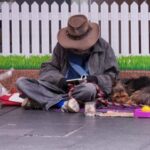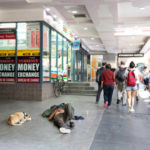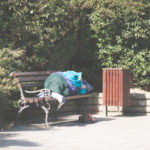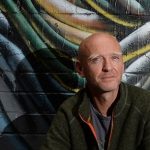As Deaths Rise, Perth Rough Sleepers Demand Housing: An Interview With NSPTRP’s Megan Krakouer
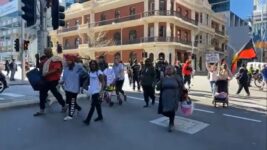
A group of Perth rough sleepers staged a rally on 14 August, shutting down a major CBD intersection. Those gathered were calling on the McGowan government to do something about upholding their human rights, especially that to adequate housing.
Homelessness in the Western Australian capital has long been at crisis point, with reported figures of up to 1,200 people sleeping on the streets. And while homelessness is a nationwide issue, it’s most pronounced in the far west of the continent.
Recent figures outline that the Greater Perth homelessness crisis is not only one that involves forgotten and marginalised people being left to survive on the streets, but it’s also a crisis in terms of lives, with 56 rough sleepers prematurely dying last year.
Central to the homelessness march was the message that Black Lives Matter. Indeed, the homelessness crisis in WA disproportionately impacts First Nations peoples, with 28 percent of those dying on the streets last year being Aboriginal or Torres Strait Islander.
Growing direct action
Homelessness was a focal point in the leadup to the WA state election in March, with Fremantle tent city having been set up in the port’s Pioneer Park. Established last Boxing Day, the homeless camp ended with most residents being moved into temporary accommodation in February.
Another such camp was formed opposite WA parliament earlier this month in Perth’s Solidarity Park. This new demonstration marked the passing of Noongar mother-of-six Alana Garlett, who died as a result of falling ill on the city streets during winter.
WA community services minister Simone McGurk points to the newly established 100 bed homeless shelter at 300 Wellington Street in the CBD. However, homelessness advocates assert that this is hardly enough for a population that numbers up to more than ten times its capacity.
But this issue goes back much further. In March 2015, the Matagarup Refugee Camp was established as a safe space for Noongar rough sleepers, as well as to demonstrate the forced closure of remote Aboriginal communities in Western Australia.
The Matagarup camp was repeatedly raided by WA police until it disbanded in the months following.
Advocating for real change
National Suicide Prevention and Trauma Recovery Project (NSPTRP) founder Gerry Georgatos and director Megan Krakouer travelled south of Perth to Bunbury last week, where they found the McGowan government’s claim that rough sleeping is not an issue on its streets a “blatant lie”.
Georgatos recently told the National Indigenous Times that research has found that 25 to 41 percent of Perth’s homeless are First Nations people, which are especially stark figures when you factor in that Aboriginal and Torres Strait Islander people account for just 2.2 percent of the state’s populace.
Sydney Criminal Lawyers spoke to Mineng woman and NSPTRP director Megan Krakouer about the recent Perth homeless march, the belligerence the WA government holds towards people without a fixed address, and how homelessness advocates are going to keep pushing to see real action.
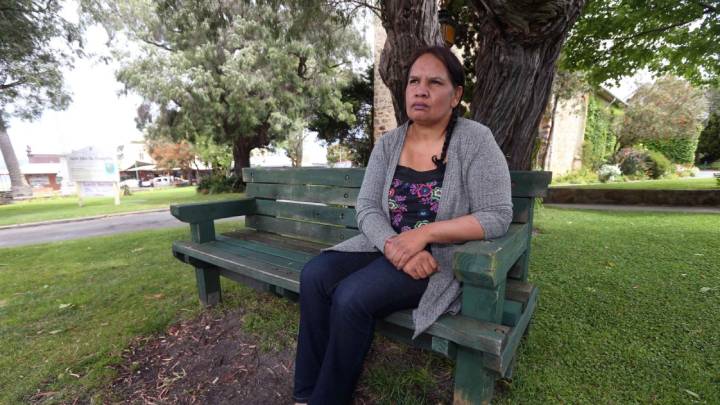
Recently, a group of Perth’s rough sleepers staged a protest at a major intersection in the CBD. This followed the establishment of a homeless camp out the front of WA parliament earlier this month.
Megan, why are the city’s homeless taking these actions?
Perth’s homeless are exasperated with the state government, as are many of their advocates and similarly homeless support services.
According to experts, such as researchers Gerry Georgatos and Professor Lisa Wood, Perth’s and WA’s street homelessness has dramatically increased.
In fact, it’s doubled. Street present homelessness in Perth and Greater Perth numbers nearly 1,200 people.
The state government is not building social housing and, in fact, during the tenure of their near five year reign as government, they’ve gone backwards – selling off more than 1,200 social houses.
This has gone from 44,000 social houses, when they came into government, to just over 42,500 now.
Gerry says it best, “Never in my wildest nightmare could I imagine a Labor government responsible for less public housing stock than their predecessor, a Liberal government.”
In fact, their predecessors, the Liberals, built 5,000 social houses to take public housing in WA from 39,000 to 44,000.
The homeless no longer trust and are voicing strong. First Nations homeless are even less likely to get housed, so they’re calling out “Black Lives Matter”.
Gerry reports that 28 percent of the 1,200 homeless are my First Nations people. He also reports that a third of the homeless are migrant born. It’s tragic.
Perth has just endured two months of cold and heavy rains. From his Georgatos Foundation, Gerry distributed 340 wet weather hooded windcheaters to Perth homeless to protect them from the relentless rains.
Last week, I travelled with Gerry to Bunbury – 200 kilometres south of Perth – to help out with the street present homeless there.
It shocked me to find that 80 percent of Bunbury’s street homeless are First Nations. Gerry’s foundation handed out fifty three windcheaters and $2,000 worth of $50 grocery vouchers.
I was distressed hearing their stories, such as being on the social housing waitlist for eight years.
During last year’s COVID lockdowns, the National Suicide Prevention and Trauma Recovery Project accommodated 43 homeless souls. The state government managed a meagre 20 people, while NSW and Victoria accommodated thousands in hotels.
So, the homeless see that our WA government do not prioritise them. They do not care.
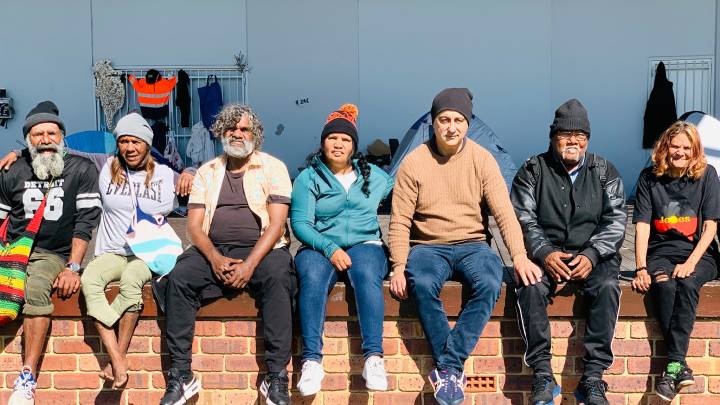
As you mentioned, the recent street protest prioritised the Black Lives Matter message. Can you speak on why Perth’s homeless have made this a central theme to their demonstrations?
Deaths in custody are the tip of the iceberg. The 339 recommendations of the Royal Commission into Aboriginal Deaths in Custody (RCIADIC) have not been fully implemented.
This further demonstrates the lack of political will by the government, both federal and state.
The inaction/s of the government is contributing significantly to death in our community. And this is evidenced by Western Australia being the “mother of all gaols, nationwide”.
The lack of accountability and culpability is causing devastation in my community and, consequently, we’re recording higher than ever suicides amongst my people. This is unacceptable and my people have had enough.
Just as the recommendations of the RCIADIC have not been fully implemented, so too has the need for housing not been addressed.
Families have been on the waitlist for 5 years, 10 years, 14 years. Stable accommodation is a fundamental human right.
Forty percent of First Nations people across the country fall below the poverty line, in Western Australia that’s 60 percent. One in thirteen Aboriginal men are in prison and that’s on the rise.
This begs the question, with WA and its $5 billion dollar surplus, does the government care about its constituents and importantly, the First Nations people of this land.
Black Lives Matter is central because the voices and cries of our people are being ignored. Successive governments have failed my people and this in Western Australia is a housing crisis.
The most marginalised and critically vulnerable are being left behind repeatedly.
Over 50 rough sleepers died in Perth last year. And these numbers have continued into 2021. Why is this happening?
In 2020, Professor Lisa Wood recorded 56 deaths on Perth’s streets, which were reported to her UWA team by hospitals.
But it’s even higher. It would be if the Coroner’s Office would release this information in real time.
Gerry has been arguing for years that, on average, there’s at least one homeless death a week on Perth’s streets. He says it’s between 400 to 600 homeless deaths on the streets nationally.
According to Gerry, street homeless people die each year at ten times the rate compared to household Australians, and, on average, they have half the life expectancy of all other Australians.
They die on the streets because of the obvious: exposure to the elements and being isolated in unaddressed health battles.
What has the state government been doing to address the homelessness problem?
They haven’t been. It has been blood from a stone.
What little they’re doing – such as a hostel of 100 beds for interim stays – has been a response only to the relentless activism of homelessness advocates, such as Gerry, Dr Betsy Buchanan, Jesse Noakes, Michelle McKenzie and Professor Pietropiccolo.
We are in the unenvious position of having to shame the government.
This government would not even fund the nation’s most successful eviction prevention service, the Ngalla Maya Aboriginal Corporation’s First Nations Homelessness Project.
The project services the most vulnerable families in Perth and has a record of 365 eviction preventions and tenancy stabilisations from 378 efforts in the last three and a half years.
The government funded services don’t come anywhere near the FNHP service.
The issue with homelessness is not new in Perth. There was the Fremantle homeless tent city set up in the lead up to the March state election this year.
There were questions around the approach taken to the homeless at the onset of the pandemic last year. And there was the Matagarup Aboriginal Refugee Camp that grabbed national attention in early 2015.
Why has Perth’s homelessness issue been so pervasive over the last half decade?
Western Australia is the nation’s most embarrassing jurisdiction. They are a conservative nightmare with a racist and classist dictate.
Let’s not forget WA gaols First Nations peoples at the world’s highest rate – that says it all about WA.
Yes, WA is doing the symbolism and ticking boxes – with Aboriginal and Torres Strait Islander flags, Welcomes to Country, Aboriginal words for place names, “reconciliation plans”, rhetoric and words, words and more words – but no deeds of any substantive note.
You met with the WA deputy premier last week and the communities minister on Monday, what have you been calling on them to do?
They have control of both houses of parliament, and they can end homelessness in all its forms.
They can invest like never before in turning around the lives of our incarcerated and in real suicide prevention.
They can do more for the poor. They can start by funding the humble FNHP and rolling it out statewide.
They should fully fund the WA response of the National Suicide Prevention and Trauma Recovery Project and other truly assertive outreach services. They have to be honourable.
I’ve also advised them of the soon-to-be served Banksia Juvenile Detention Centre Class Action, the largest of its type. I’ve been registering plaintiffs, and we are over 200 already and heading to over 1,000.
It’s being led by the Palm Island lawyer, Stewart Levitt and lawyer Dana Levitt, and the relentless humanitarian Gerry Georgatos.
WA imprisons First Nations people at a higher rate than any other state or territory, with 4.1 percent of its First Nations population behind bars, compared to 2.9 percent in the Northern Territory and a national rate of 2.6 percent.
Gerry has often described WA as the mother of all gaolers of First Nations peoples. One in thirteen of WA First Nations men are in prison – the world’s highest rate. Aboriginal deaths in custody bring a focus to this disturbing rate of imprisonment.
So, if the WA government won’t listen to its people, we have to give it a chance to listen to the courts, just like the Commonwealth government did with the Robodebt Class Action.
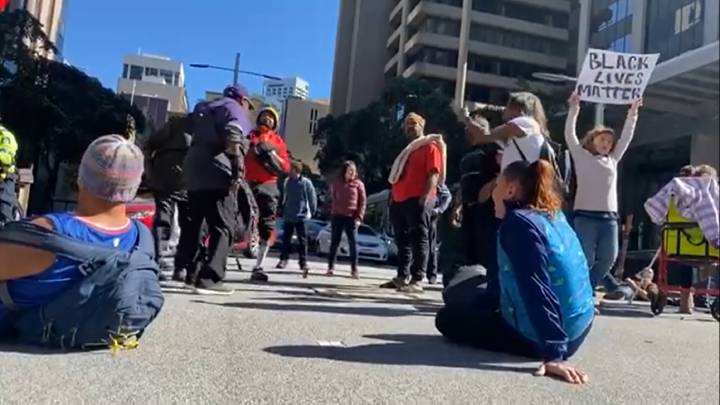
And lastly, Megan, what are you expecting to happen from here? Is this a crisis that the government is going to act upon, or will it attempt to push it to the side, as it did when it raided Matagarup back in 2015?
Of course, if we do little, they will push it aside, as all previous WA Liberal and Labor governments have callously done.
Therefore, we have to keep fighting, rallying and speaking out. And not just sell out for crumbs and tokenisms but hold out loud and in their faces till they do right.


